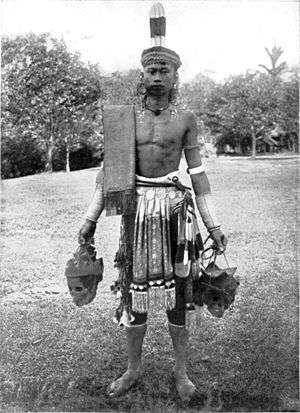Headhunting
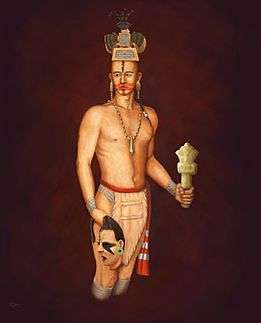
Headhunting is the practice of taking and preserving a person's head after killing the person. Headhunting was practised in historic times in parts of Oceania, South and Southeast Asia, West and Central Africa, and Mesoamerica, as well as among certain tribes of the Celts, the West Germanic tribes, and Scythians of ancient Europe. It occurred in Europe until the 19th century in Montenegro, Croatia, Albania and western parts of Herzegovina, and to the end of the Middle Ages in Ireland and the Anglo-Scottish border regions.[1]
As a practice, headhunting has been the subject of intense discussion within the anthropological community as to its possible social roles, functions, and motivations. Themes that arise in anthropological writings about headhunting include mortification of the rival, ritual violence, cosmological balance, the display of manhood, cannibalism, prestige, and as a means of securing the services of the victim as a slave in the afterlife.[2]
Today's scholars generally agree that its primary function was ceremonial and that it was part of the process of structuring, reinforcing, and defending hierarchical relationships between communities and individuals. Some experts theorize that the practice stemmed from the belief that the head contained "soul matter" or life force, which could be harnessed through its capture.
Asia and Oceania
Melanesia


Headhunting was practised by many Austronesian people in Southeast Asia and the Pacific Islands. Headhunting has at one time or another existed among most of the peoples of Melanesia,[3] including New Guinea.[4] A missionary found 10,000 skulls on Goaribari Island in 1901.[5]
In the past, Marind-anim in New Guinea were famed because of headhunting.[6] This was rooted in their belief system and linked to the name-giving of the newborn.[7] The skull was believed to contain a mana-like force.[8] Headhunting was not motivated primarily by cannibalism, but the dead person's flesh was consumed.[9]
The Korowai, a Papuan tribe in the southeast of Irian Jaya, live in tree houses, some nearly 40 metres high, presumably as protection against a tribe of neighbouring headhunters, the Citak.[10] Some believe that Michael Rockefeller may have been taken by headhunters in the Asmat region of New Guinea as recently as 1961.
In the book by Jack London of his 1905 adventure in the Snark, he writes of the headhunters of Malaita attacking his ship during a stay in Langa Langa Lagoon, particularly around Laulasi Island. Captain Mackenzie of the blackbirding vessel Minolta was beheaded as retribution for the attack of another village during a labour "recruiting" drive. The ship apparently "owed" several more heads before the score was even.[11]
Southeast Asia
In Southeast Asia, anthropological writings exist on the Murut, Ilongot, Igorot, Iban, Dayak, Berawan, Wana, and Mappurondo tribes. Among these groups, headhunting was usually a ritual activity rather than an act of war or feuding and involved the taking of a single head. Headhunting acted as a catalyst for the cessation of personal and collective mourning for the community's dead. Ideas of manhood and marriage were encompassed in the practice, and the taken heads were highly prized. Other reasons for headhunting included capture of enemies as slaves, looting of valuable properties, intra and inter-ethnic conflicts and territorial expansion.
Italian anthropologist and explorer Elio Modigliani visited the headhunting communities in South Nias (an island to the west of Sumatra) in 1886, and produced an in depth study of their society and beliefs. He found that the main purpose of headhunting was the belief that by owning another person's skull, the victim would serve as a slave of the owner for eternity in the afterlife, and thus human skulls were a valuable commodity.[12] Sporadic headhunting continued in Nias island until very recent times, the last reported incident dating from 1998.
Headhunting was practised among Sumba people until the early 20th century. It is done only in a large war parties, not in silence and secrecy like in hunting wild animals.[13] The skulls collected were hung on the skull tree erected in the center of village. As recently as 1998, in Waikabubak, a major clash of clans resulted some people decapitated,[14] reminiscent of the old headhunting tradition.
Kenneth George wrote about annual headhunting rituals that he observed among the Mappurondo religious minority, an upland tribe in the southwest part of the Indonesian island of Sulawesi. Actual heads are not taken; instead, surrogate heads are used, in the form of coconuts. The ritual, called pangngae, takes place at the conclusion of the rice-harvesting season. It functions to bring an end to communal mourning for the deceased of the past year; express intercultural tensions and polemics; allow for a display of manhood; distribute communal resources; and resist outside pressures to abandon Mappurondo ways of life.
Around the 1930s, headhunting was suppressed among the Ilongot in the Philippines by the US authorities. The Igorot in the Philippines also practiced headhunting.
The Wa tribe, whose domain straddles the Burma-China border, were once known as the Wild Wa for their "savage" behavior. The Wa were, until the 1970s, ferocious headhunters.[15]
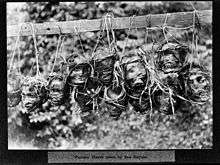
In Sarawak, the north-western region on the island of Borneo, the colonial dynasty James Brooke and his descendants eradicated headhunting in the hundred years before World War II. Before Brooke's arrival, the Iban managed to migrate from the middle Kapuas region into the upper Batang Lupar river region by fighting and displacing the small existing tribes such as the Seru and Bukitan. Another successful migration by the Iban was from the Saribas region into the Kanowit area in the middle of the Batang Rajang river, led by the famous Mujah "Buah Raya," by fighting and displacing the existing tribes there like the Kanowit and Baketan.
Brooke first encountered the headhunting Ibans of the Saribas-Skrang in Sarawak at the Battle of Betting Maru in 1849 and the proposed signing of the Saribas Treaty between Brooke and the Iban chief of that region by the name of Orang Kaya Pemancha Dana "Bayang". Subsequently, the Brooke dynasty expanded their territory from the first small Sarawak region to the present-day whole size of the state of Sarawak, by enlisting the Malay, Iban and other natives as a large but unpaid force to crush and pacify any rebellions in the states. The Brooke government disallowed headhunting ("ngayau" in Iban language) with punishments for disobeying the Rajah-led government decree, but allowed the same practice during expeditions sanctioned by the Brooke government. The natives who participated in Brooke-approved punitive expeditions were exempted from paying annual tax to the Brooke government and/or given new territories for further migrations in return for their service. There were intra-tribal and intertribal headhunting.
The most famous Iban warrior against the colonial Brooke government was Libau "Rentapi". The Brooke government had to send three punitive expeditions in order to defeat Rentapi at his fortress on the top of Sadok Hill.
The third major migration by the Iban from upper Batang Ai region in the Batang Lupar region into Katibas and onwards to Baleh/Mujong region in the upper Batang Rajang region by fighting and displacing the existing tribes there who are known to the Iban as Kayan, Kajang, Ukits, etc. The last migrations into new territories obtained by the Brooke government were mostly sanctioned by the government and thus peaceful endeavours. There were sacred ritual ceremonies with special and complex incantations to invoke god's blessings, associated with headhunting among the [Iban people] of Sarawak such as Bird Festival in the Saribas/Skrang region and Proper Festival in the Baleh region in order to become effective warriors.
The most recent reemergence of headhunting in Sarawak was during the Japanese occupation during the Second World War, during the confrontation by the Sukarno-led Indonesia against the formation of the Federation of Malaysia between what was then Malaya, Singapore, Sabah and Sarawak, and during the communist insurgency in Sarawak and what was then Malaya. Hence, the Iban were famous for headhunting, and later known to be good rangers and trackers during military operations with fourteen awarded medals of valour and honour.
There have been serious outbreaks of inter-ethnic violence on the island of Kalimantan since 1997, involving the indigenous Dayak peoples and immigrants from the island of Madura, such as the Sambas riots and Sampit conflict. In 2001 during the Sampit conflict in the Central Kalimantan town of Sampit, at least 500 Madurese were killed and up to 100,000 Madurese were forced to flee. Some Madurese bodies were decapitated in a ritual reminiscent of the headhunting tradition of the Dayaks of old.[16]
The Ambonese, a tribe of mixed Malay-Papuan origin living in the Moluccas, were fierce headhunters until the Dutch colonial rule in Indonesia.[17]
New Zealand
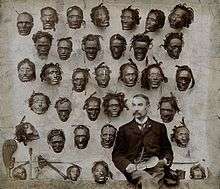
In what is now known as New Zealand, the Māori preserved the heads of enemies, removing the brain and eyes, and smoking the head. Māori are attempting to reclaim the heads of their ancestors held in museums outside New Zealand. Twenty heads were returned to them by French authorities in January 2012. The heads, repatriated from the French museums, were sold to European collectors in the late 1800s, having been 'made to order' in some instances.[18]
China
During the Spring and Autumn period and Warring States period, Qin soldiers were prone to collect their enemies' heads. Most of the soldiers were conscripted serfs and were not paid. Instead, the soldiers earned promotions and rewards by collecting the heads of enemies. Heads of executed criminals continued to be displayed in public spaces up to the 20th century.
Japan
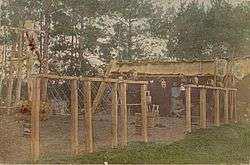
Tom O'Neill wrote: "Samurai also sought glory by headhunting. When a battle ended, the warrior, true to his mercenary origins, would ceremoniously present trophy heads to a general, who would variously reward him with promotions in rank, gold or silver, or land from the defeated clan. Generals displayed the heads of defeated rivals in public squares."[19]
Taiwan
Headhunting was a common practice among Taiwanese aborigines. All tribes practised headhunting except the Yami people, who were previously isolated on Orchid Island as well as ethnically and culturally Ivatan people and thus associated with the peoples of the Philippines.
Taiwanese Plains Aborigines, Taiwanese people (Han) and Japanese settlers were choice victims of headhunting raids by Taiwanese Mountain Aborigines, particularly the latter two groups, who were considered invaders, liars and enemies. A headhunting raid would often strike at workers in the fields or employ the ruse of setting a dwelling alight and then decapitating the inhabitants as they fled the burning structure. The practice continued during the Japanese occupation of Taiwan but ended in the 1930s due to the strict attention of the colonial Japanese government.
The Taiwanese Aboriginal tribes who were previously allied with the Dutch against the Chinese during the Guo Huaiyi Rebellion in 1652 turned against the Dutch during the Siege of Fort Zeelandia and defected to Koxinga's Chinese forces.[20] The Aboriginals (Formosans) of Sincan defected to Koxinga after he offered them amnesty, the Sincan Aboriginals then proceeded to work for the Chinese and behead Dutch people in executions, the frontier aboriginals in the mountains and plains also surrendered and defected to the Chinese on May 17, 1661, celebrating their freedom from compulsory education under the Dutch rule by hunting down Dutch people and beheading them and trashing their Christian school textbooks.[21]
At the Battle of Tamsui in the Keelung Campaign during the Sino-French War on 8 October 1884, the Chinese took prisoner and beheaded 11 French marines who were injured in addition to La Gailissonniere's captain Fontaine and used bamboo poles to display the heads in public, to incite anti-French feelings in China pictures of the decapitation of the Frenchmen were published in the Tien-shih-tsai Pictorial Journal in Shanghai.[22]
"A most unmistakable scene in the market place occurred. Some six heads of Frenchmen, heads of the true French type were exhibited, much to the disgust of foreigners. A few visited the place where they were stuck up, and were glad to leave it—not only on account of the disgusting and barbarous character of the scene, but because the surrounding crowd showed signs of turbulence. At the camp also were eight other Frenchmen's heads, a sight which might have satisfied a savage or a Hill-man, but hardly consistent with the comparatively enlightened tastes, one would think, of Chinese soldiers even of to-day. It is not known how many of the French were killed and wounded; fourteen left their bodies on shore, and no doubt several wounded were taken back to the ships. (Chinese accounts state that twenty were killed and large numbers wounded.)In the evening Captain Boteler and Consul Frater called on General Sun, remonstrating with him on the subject of cutting heads off, and allowing them to be exhibited. Consul Frater wrote him a despatch on the subject strongly deprecating such practices, and we understand that the general promised it should not occur again, and orders were at once given to bury the heads. It is difficult for a general even situated as Sun is—having to command troops like the Hillmen, who are the veriest savages in the treatment of their enemies—to prevent such barbarities.
"It is said the Chinese buried the dead bodies of the Frenchmen after the engagement on 8th instant by order of General Sun. The Chinese are in possession of a machine gun taken or found on the beach.
— James Wheeler Davidson, "The island of Formosa, past and present: History, people, resources, and commercial prospects. Tea, camphor, sugar, gold, coal, sulphur, economical plants, and other productions, 1903,[23] also published as "The Island of Formosa: Historical View from 1430 to 1900"[24]
Han and Taiwanese Aboriginals revolved against the Japanese in the Beipu Uprising in 1907 and Tapani Incident in 1915. The Seediq aboriginals revolted against the Japanese in the 1930 Wushe Incident and resurrected the practice of headhunting, beheading Japanese during the revolt.
Indian Subcontinent
Headhunting has been a practice among the Naga tribes of India and Myanmar. The practice was common up to the 20th century and may still be practised in isolated Naga tribes of Burma. Many of the Naga warriors still bear the marks (tattoos and others) of a successful headhunt. In Assam, in the northeast of India, all the peoples living south of the Brahmaputra River—Garos, Khasis, Nagas, and Kukis—used to be headhunters including the Mizo of the Lushai Hills who also hunt heads of their enemies which was later abolished with Christianity introduced in the region.[25]
Americas
Amazon
_(1450150520).jpg)
Several tribes of the Jivaroan group including the Shuar in Eastern Ecuador and Northern Peru, along the rivers Chinchipe, Bobonaza, Morona, Upano, and Pastaza, main tributaries of the Amazon, practised headhunting for trophies that were then shrunk, know locally as Tzan-Tzas which they believed housed the soul of the person killed. The Shuar today still produce replicas using the original process from the skinheads of monkeys and sloths in order to sell them to tourists. It is believed that there are still splinter groups in the local tribes that continue with these practises of their forefathers whenever there is a tribal feud over territory or as revenge for a crime of passion. .
The Quechua Lamistas in Peru also used to be headhunters.[26]
Mesoamerican civilizations
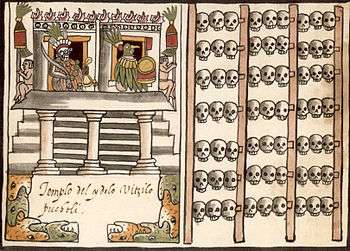
A tzompantli is a type of wooden rack or palisade documented in several Mesoamerican civilizations that was used for the public display of human skulls, typically those of war captives or other sacrificial victims.
There is evidence that a tzompantli-like structure has been excavated from the Proto-Classic Zapotec civilization at the La Coyotera, Oaxaca, site, dated from c. 2nd century BCE to the 3rd century CE.[27] Tzompantli are also noted in other Mesoamerican pre-Columbian cultures, such as the Toltec and Mixtec.
Based on numbers given by the Conquistador Andrés de Tapia and Fray Diego Durán, Bernard Ortiz de Montellano[28] has calculated that there were at most 60,000 skulls on the Hueyi Tzompantli (great Skullrack) of Tenochtitlan. There were at least five more skullracks in Tenochtitlan, but, by all accounts, they were much smaller.
Other examples are indicated from Maya civilization sites. A particularly fine and intact inscription example survives at the extensive Chichen Itza site.[29]
Europe
Celts
The Celts of Europe practised headhunting as the head was believed to house a person's soul. Ancient Romans and Greeks recorded the Celts' habits of nailing heads of personal enemies to walls or dangling them from the necks of horses.[30] Headhunting was still practised for a great deal longer by the Celtic Gaels—in the Ulster Cycle, Cúchulainn beheads the three sons of Nechtan and mounts their heads on his chariot—though this was probably as a traditional, rather than religious, practice. The practice continued approximately to the end of the Middle Ages in Ireland and the Anglo-Scottish marches.[25] The religious reasons for collecting heads was likely lost after the Celts' conversion to Christianity. Heads were also taken among the Germanic tribes and among Iberians, but the purpose is unknown.
Scythians
The Scythians were excellent horsemen, and some of their tribes, Herodotus wrote, were indeed wild and fierce, practising human sacrifice, drinking blood, scalping their enemies and drinking wine from the enemies' skulls.[31]
Montenegrins
The Montenegrins are an ethnic group in Southeastern Europe who are centered around the Dinaric mountains. They practiced headhunting until 1876, allegedly carrying the head from a lock of hair grown specifically for that purpose.[32] In the 1830s, Montenegrin ruler Petar II Petrović-Njegoš started building a tower called "Tablja" above Cetinje Monastery. Tower was never finished, and Montenegrins used it to display Turkish heads. King Nicholas I of Montenegro ordered in 1876 that Montenegrins should stop doing it, because it was seen as very barbaric practice by European diplomats of that time. Tablja was demolished in 1937.
Ottoman Turks
Ottoman Turks are also alleged to have taken heads of the Montenegrins, when they came into conflict.[33]
Modern times
World War II
During World War II, Allied (specifically including American) troops occasionally collected the skulls of dead Japanese as personal trophies, as souvenirs for friends and family at home, and for sale to others. (The practice was unique to the Pacific theater; German and Italian skulls were not taken.) The Commander in Chief of the Pacific Fleet, in September 1942, mandated strong disciplinary action for any soldier who took enemy body parts as souvenirs. Nevertheless, trophy-hunting persisted: Life, in its issue of May 22, 1944, published a photograph of a young woman posing with the autographed skull sent to her by her Navy boyfriend, causing significant public outcry.[34][35]
However, despite the voiced objections of private citizens, religious leaders and government officials, it has been argued that many Americans viewed the Japanese as lesser people.[36] In Borneo, this view of the Japanese may have been shaped by the behavior of the Japanese Army in that area The Dayaks of Borneo formed a force to help the Allies following their ill treatment by the Japanese. Australian and British special operatives of Z Special Unit transformed some of the inland Dayak tribesmen into a thousand-man headhunting army. This army of tribesmen killed or captured some 1,500 Japanese soldiers.[37]
Vietnam War
During the Vietnam War, some US soldiers again engaged in the taking of "trophy skulls".[38][39] This practice is depicted in the 1995 film Dead Presidents.
War in Afghanistan
A Gurkha soldier beheaded a supposed Taliban leader and took it from the battlefield to base for identification.[40]
Gallery
-
Head trophy, Munduruku Indians, northern Brazil, c. 1820
-

Captives who fell into the hands of Dahomey Amazons were often decapitated
-
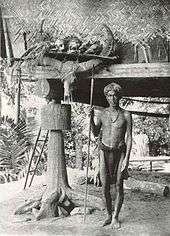
An Ifugao warrior with some of his trophies, Philippines, 1912
-

Dayak women dancing with human heads, 1912
-
%2C_A_back_view_of_Onikojima_Yatar%C3%B4_Kazutada_in_armor_holding_a_spear_and_a_severed_head.jpg)
Japanese samurai holding a severed head
-

Severed heads of Nanking Massacre victims in 1937-38
See also
Notes
- ↑ Encyclopædia Britannica (2009-02-23). "headhunting (anthropology) – Britannica Online Encyclopedia". Britannica.com. Retrieved 2010-05-25.
- ↑ E-Modigliani, "Un viaggio a Nias" Fratelli Treves Editori Milano 1890
- ↑ Some Head-Hunting Traditions of Southern New Guinea, by Justus M. van der Kroef, American Anthropologist, New Series, Vol. 54, No. 2 (Apr. – Jun. 1952), pp. 221–235
- ↑ "Hunter Gatherers – New Guinea". Climatechange.umaine.edu. Retrieved 2010-05-25.
- ↑ Laurence Goldman (1999).The Anthropology of Cannibalism. p.19.
- ↑ Nevermann 1957: 9
- ↑ Nevermann 1957: 111
- ↑ Nevermann 1957: blurb
- ↑ Nevermann 1957: 13
- ↑ "Head-Hunters Drove Papuan Tribe Into Tree-Houses". Sciencedaily.com. 1998-03-09. Retrieved 2010-05-25.
- ↑ Jack London (1911). The Cruise of the Snark. The Cruise of the Snark. Harvard University Digitized Jan 19, 2006.
- ↑ E.Modigliani, "Un viaggio a Nias", Fratelli Treves Editori Milano 1890
- ↑ Hoskins, Janet. The Play of Time: Kodi Perspectives on Calendars, History, and Exchange. Berkeley: University of California Press, c1993 1993. http://ark.cdlib.org/ark:/13030/ft0x0n99tc/ p.312-314
- ↑ "Tragedy in Sumba".. insideindonesia.org
- ↑ Soldiers of Fortune, TIME Asia
- ↑ "Behind Ethnic War, Indonesia's Old Migration Policy". Globalpolicy.org. 2001-03-01. Retrieved 2010-05-25.
- ↑ http://www.nunusaku.com/pdfs/politicians_magicans.pdf
- ↑ http://tvnz.co.nz/national-news/weather-delays-return-toi-moko-4703230
- ↑ "Samurai: Japan's Way of the Warrior". National Geographic Magazine.
- ↑ Covell, Ralph R. (1998). Pentecost of the Hills in Taiwan: The Christian Faith Among the Original Inhabitants (illustrated ed.). Hope Publishing House. pp. 96–97. ISBN 0932727905. Retrieved December 10, 2014.
- ↑ Hsin-Hui, Chiu (2008). The Colonial 'civilizing Process' in Dutch Formosa: 1624 - 1662. Volume 10 of TANAP monographs on the history of the Asian-European interaction (illustrated ed.). BRILL. p. 222. ISBN 900416507X. Retrieved December 10, 2014.
- ↑ Maritime Taiwan.
- ↑ The Island of Formosa, Past and Present.
- ↑ The Island of Formosa.
- 1 2 http://www.lard.net/headhunters.html, Encyclopædia Britannica entry 1996
- ↑ Plants, Health And Healing.
- ↑ Spencer (1982), pp.236–239
- ↑ Ortíz de Montellano 1983
- ↑ Miller and Taube (1993), p.176.
- ↑ see e.g. Diodorus Siculus, 5.2
- ↑ Jona Lendering. "Summary of and commentary on Herodotus' Histories, book 4". Livius.org. Retrieved 2010-05-25.
- ↑ Albania and the Albanians.
- ↑ "Head-hunting in Europe: Montenegrin heroes, Turkish barbarians and Western observers = Chasse aux têtes en Europe : Héros monténégrins, barbares turcs et observateurs occidentaux".
- ↑ Fussel 1990: 117
- ↑ Harrison 2006: 817ff
- ↑ Weingartner 1992: 67
- ↑ 'Guests' can succeed where occupiers fail, November 9, 2007
- ↑ Michelle Boorstein (2007-07-03). "Eerie Souvenirs From the Vietnam War". Washingtonpost.com. Retrieved 2010-06-26.
- ↑ "Signs of the Times – Trophy Skulls". George.loper.org. 1996-08-08. Archived from the original on October 4, 2009. Retrieved 2010-05-25.
- ↑ "Gurkha who beheaded Taliban soldier in Afghanistan battle cleared to return to duty". Mail Online. October 17, 2011.
References
- Davidson, James Wheeler, The island of Formosa, past and present: History, people, resources, and commercial prospects. Tea, camphor, sugar, gold, coal, sulphur, economical plants, and other productions (London, 1903)
- Davidson, James Wheeler, The Island of Formosa: Historical View from 1430 to 1900 (London, 1903)
- Fussell, Paul (1990). Wartime: Understanding and Behavior in the Second World War. New York: Oxford University Press.
- George, Kenneth (1996). Showing signs of violence: The cultural politics of a twentieth-century headhunting ritual. Berkeley: University of California Press. ISBN 0-520-20041-1.
- Harrison, Simon (2006). "Skull Trophies of the Pacific War: Transgressive Objects of remembrance./Les Trophees De la Guerre Du Pacifique Des Cranes Comme Souvenirs Transgressifs". Journal of the Royal Anthropological Institute. 12 (4): 817. doi:10.1111/j.1467-9655.2006.00365.x.
- Nevermann, Hans (1957). Söhne des tötenden Vaters. Dämonen- und Kopfjägergeschichten aus Neu-Guinea. Das Gesichtder Völker (in German). Eisenach • Kassel: Erich Röth-Verlag. The title means Sons of the killing father. Stories about demons and headhunting, recorded in New Guinea.
- Rubenstein, Steven L. (2006). "Circulation, Accumulation, and the Power of Shuar Shrunken Heads". Cultural Anthropology. 22 (3): 357–399. doi:10.1525/can.2007.22.3.357.
- Tsai, Shih-shan Henry (2009). Maritime Taiwan: Historical Encounters with the East and the West (illustrated ed.). M.E. Sharpe. ISBN 0765623285. Archived from the original on July 13, 2010. Retrieved 24 April 2014.
- James J. Weingartner (1992) "Trophies of War: U.S. Troops and the Mutilation of Japanese War Dead, 1941 – 1945" Pacific Historical Review
- Yamada, Hitoshi (2015). Religionsethnologie der Kopfjagd (in Japanese). Tokyo: Chikuma Shobo. ISBN 978-4480843050.
Further reading
- Head-Hunting Roman Cavalry - article about single combat and the taking of heads and scalps as trophies by Roman warriors
- Les Romains, chasseurs de têtes - paper by Jean-Louis Voisin about the Roman practice of head hunting
- Cornélis De Witt Willcox (1912). The head hunters of northern Luzon: from Ifugao to Kalinga, a ride through the mountains of northern Luzon : with an appendix on the independence of the Philippines. Volume 31 of Philippine culture series. Franklin Hudson Publishing Co. Retrieved 24 April 2014.
